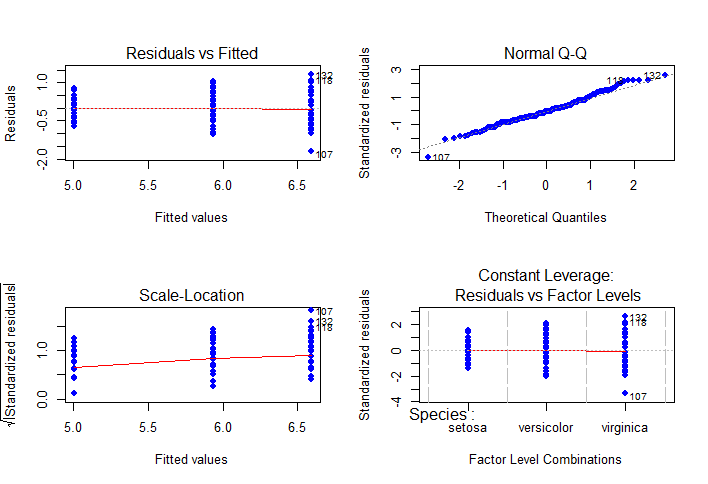Post hoc tests are designed for situations in which we have already obtained a significant omnibus F-test with a factor that consists of three or more means and additional exploration of the differences among means is needed to provide specific information on which means are significantly different from each other. In our example, we saw that Sepal.Length was significantly different between the 3 species. Now, we want to find out which species had significantly longer Sepal.Length.
Load packages
library(tidyverse)
library(agricolae)
## Warning: package 'agricolae' was built under R version 3.3.3
Read input data
irisdata<-read_csv("irisdata.csv")
## Parsed with column specification:
## cols(
## Sepal.Length = col_double(),
## Sepal.Width = col_double(),
## Petal.Length = col_double(),
## Petal.Width = col_double(),
## Species = col_character()
## )
Convert character into factors
Since Species is not a factor, we will convert it into a factor:
irisdata$Species <- as.factor(irisdata$Species)
Fit a model and view residuals
model1 <- aov(Sepal.Length ~ Species, data=irisdata)
par(mfrow=c(2,2))
plot(model1, pch=19, col="blue")

Get summary of model
summary(model1)
## Df Sum Sq Mean Sq F value Pr(>F)
## Species 2 63.21 31.606 119.3 <2e-16 ***
## Residuals 147 38.96 0.265
## ---
## Signif. codes: 0 '***' 0.001 '**' 0.01 '*' 0.05 '.' 0.1 ' ' 1
Apply post-hoc test
hsd_result<-HSD.test(model1, "Species", group=TRUE)
hsd_result
## $statistics
## MSerror Df Mean CV MSD
## 0.2650082 147 5.843333 8.809859 0.2437727
##
## $parameters
## test name.t ntr StudentizedRange alpha
## Tukey Species 3 3.348424 0.05
##
## $means
## Sepal.Length std r Min Max Q25 Q50 Q75
## setosa 5.006 0.3524897 50 4.3 5.8 4.800 5.0 5.2
## versicolor 5.936 0.5161711 50 4.9 7.0 5.600 5.9 6.3
## virginica 6.588 0.6358796 50 4.9 7.9 6.225 6.5 6.9
##
## $comparison
## NULL
##
## $groups
## Sepal.Length groups
## virginica 6.588 a
## versicolor 5.936 b
## setosa 5.006 c
##
## attr(,"class")
## [1] "group"
This shows that the Sepal.Length of all 3 species is significantly different than one another.
<– Click here to go to the previous tutorial Click here to go to the next tutorial –>